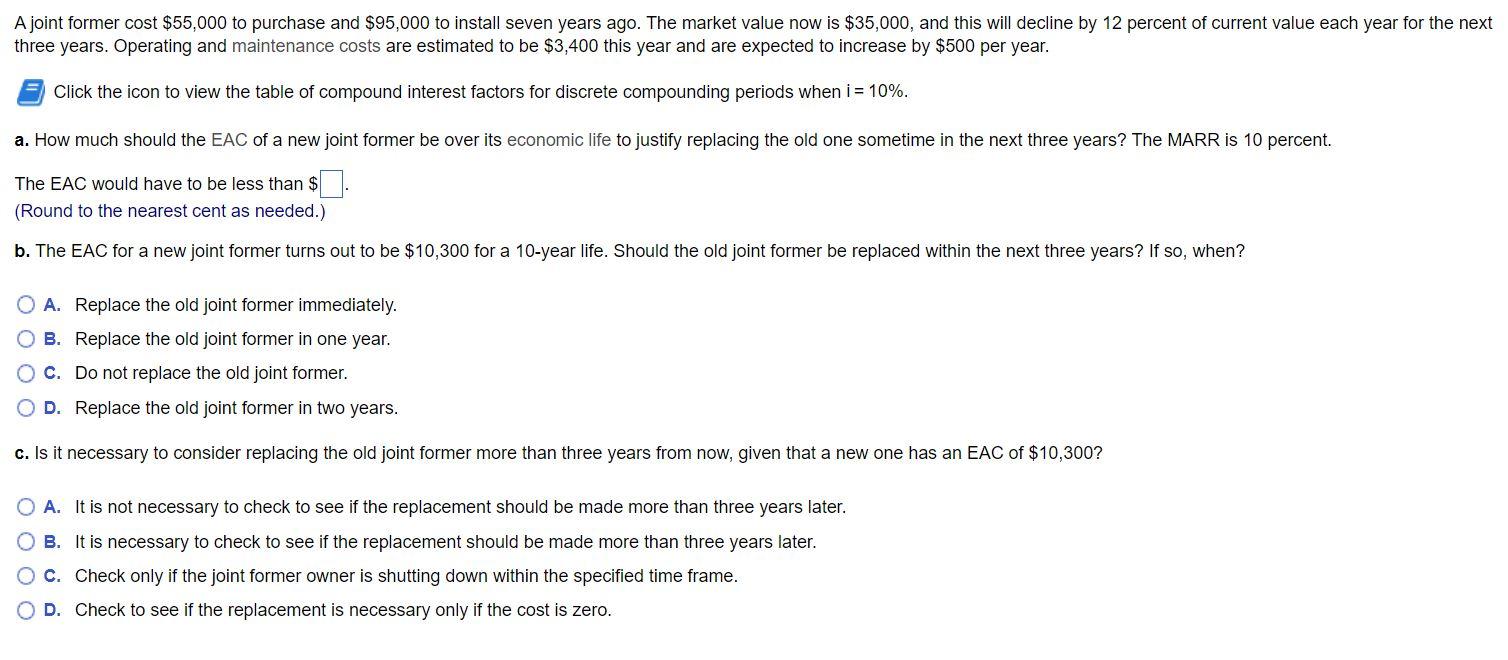
A joint former cost $55,000 to purchase and $95,000 to install seven years ago. The market value now is $35,000, and this will decline by 12 percent of current value each year for the nex three years. Operating and maintenance costs are estimated to be $3,400 this year and are expected to increase by $500 per year. Click the icon to view the table of compound interest factors for discrete compounding periods when i=10%. a. How much should the EAC of a new joint former be over its economic life to justify replacing the old one sometime in the next three years? The MARR is 10 percent. The EAC would have to be less than 9 (Round to the nearest cent as needed.) b. The EAC for a new joint former turns out to be $10,300 for a 10-year life. Should the old joint former be replaced within the next three years? If so, when? A. Replace the old joint former immediately. B. Replace the old joint former in one year. C. Do not replace the old joint former. D. Replace the old joint former in two years. c. Is it necessary to consider replacing the old joint former more than three years from now, given that a new one has an EAC of $10,300? A. It is not necessary to check to see if the replacement should be made more than three years later. B. It is necessary to check to see if the replacement should be made more than three years later. C. Check only if the joint former owner is shutting down within the specified time frame. D. Check to see if the replacement is necessary only if the cost is zero. A joint former cost $55,000 to purchase and $95,000 to install seven years ago. The market value now is $35,000, and this will decline by 12 percent of current value each year for the nex three years. Operating and maintenance costs are estimated to be $3,400 this year and are expected to increase by $500 per year. Click the icon to view the table of compound interest factors for discrete compounding periods when i=10%. a. How much should the EAC of a new joint former be over its economic life to justify replacing the old one sometime in the next three years? The MARR is 10 percent. The EAC would have to be less than 9 (Round to the nearest cent as needed.) b. The EAC for a new joint former turns out to be $10,300 for a 10-year life. Should the old joint former be replaced within the next three years? If so, when? A. Replace the old joint former immediately. B. Replace the old joint former in one year. C. Do not replace the old joint former. D. Replace the old joint former in two years. c. Is it necessary to consider replacing the old joint former more than three years from now, given that a new one has an EAC of $10,300? A. It is not necessary to check to see if the replacement should be made more than three years later. B. It is necessary to check to see if the replacement should be made more than three years later. C. Check only if the joint former owner is shutting down within the specified time frame. D. Check to see if the replacement is necessary only if the cost is zero







